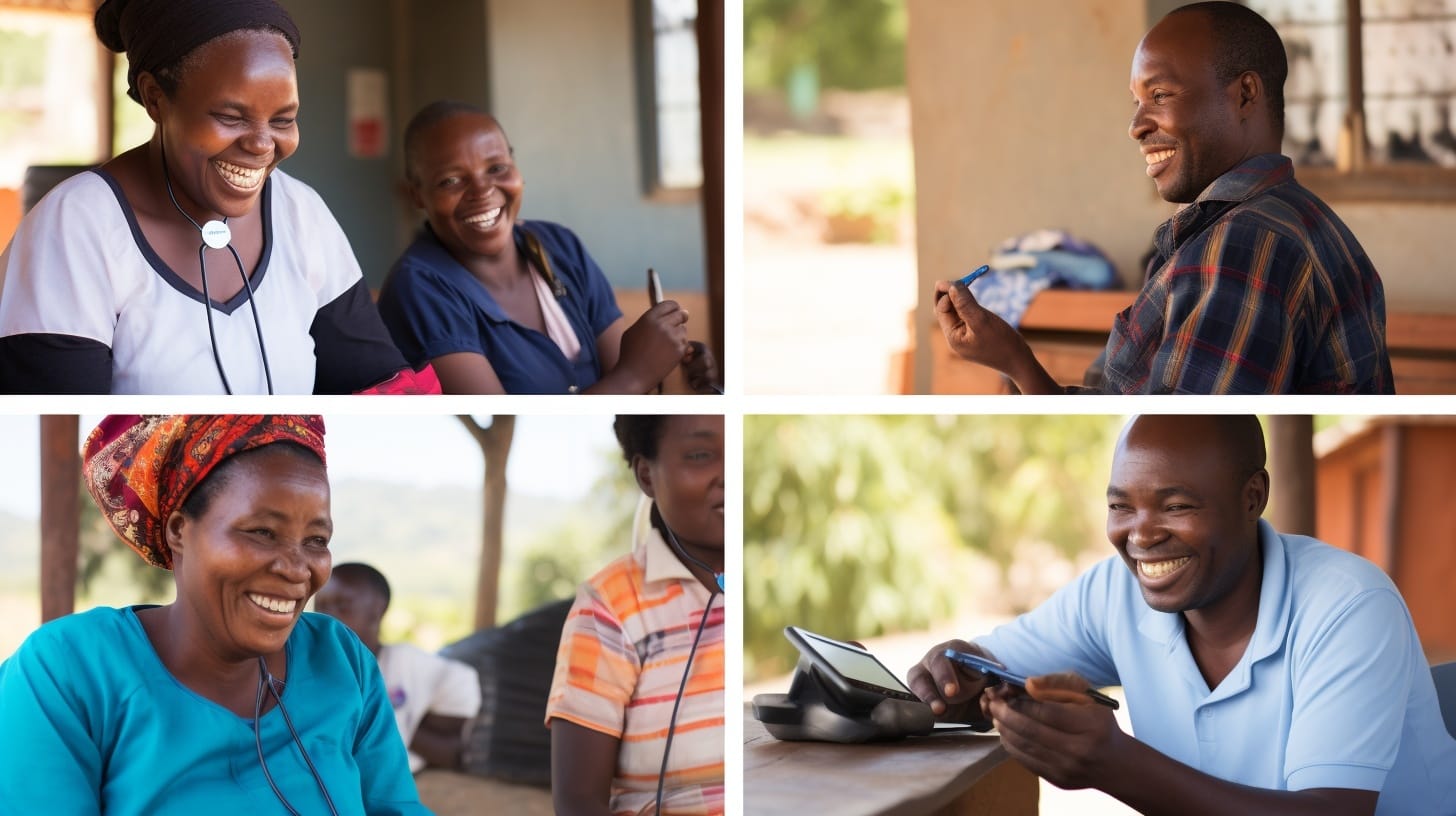The Promise and Reality of AI in Global Health
AI represents a critical opportunity to address one of the most pressing moral challenges of our time: the fact that 4.5 billion people—nearly half of humanity—lack access to essential healthcare services.

Executive Summary
Focus: Healthcare AI in Underserved Regions: An Evidence-Based Assessment
Artificial intelligence (AI) represents a critical opportunity to address one of the most pressing moral challenges of our time: the fact that 4.5 billion people—nearly half of humanity—lack access to essential healthcare services. While those in developed nations may take medical care for granted, billions face daily realities where treatable conditions become fatal, where preventable diseases go undiagnosed, and where the absence of healthcare professionals means entire communities suffer without hope of relief.
The moral imperative for AI in healthcare extends beyond technical feasibility to fundamental human dignity. When the alternative is no care at all, even imperfect AI solutions may represent life-saving interventions for the world's most vulnerable populations. The 11 million projected health worker shortage by 2030 means that without technological solutions, this healthcare crisis will only deepen.
This assessment examines both the promise and the challenges of AI healthcare validation in underserved regions, recognizing that while evidence gaps exist, the scale of human suffering demands that we pursue imperfect solutions rather than perfect inaction. The goal is not to achieve first-world standards immediately, but to meaningfully improve outcomes for those who currently have no alternatives.
I. The Moral Imperative: Why This Matters
The Human Reality Behind the Statistics
Before examining technical challenges and evidence gaps, it's essential to understand the human reality that drives the urgency behind AI healthcare initiatives. For those living in developed nations, the concept of having no access to medical care may be difficult to comprehend, but it represents daily reality for nearly half the world's population.
Consider these lived experiences:
- A pregnant woman in rural Sub-Saharan Africa facing childbirth without skilled medical attendance, where maternal mortality rates remain 100 times higher than in developed countries
- A child in a remote village with symptoms of malaria, pneumonia, or malnutrition, where the nearest healthcare facility may be days away by foot
- An elderly person with diabetes in a low-income setting, where insulin may be unavailable or unaffordable, turning a manageable condition into a death sentence
- A community health worker serving thousands of people with minimal training and no diagnostic tools, forced to make life-or-death decisions based on intuition alone
The Scale of Unmet Need
The WHO's projection of 11 million health worker shortage by 2030 is not merely a workforce statistic—it represents millions of people who will die from preventable and treatable conditions. In this context, the question is not whether AI solutions are perfect, but whether they can meaningfully improve outcomes for people who currently have no alternatives.
When the baseline is zero healthcare access, even imperfect AI-assisted diagnosis, treatment guidance, or health monitoring represents transformative improvement. A diagnostic tool that achieves 80% accuracy in a setting with no diagnostic capabilities whatsoever can save countless lives.
The Moral Case for Imperfect Solutions
Those with access to world-class healthcare systems may instinctively apply high standards to AI healthcare solutions. However, this perfectionist approach can become a barrier to helping those who need it most. The ethical framework shifts when considering:
- Incremental improvement over no care: An AI system that reduces diagnostic errors by 50% in a setting with no trained physicians represents significant progress
- Scalability over perfection: A simple AI tool that can be deployed to serve millions may have greater humanitarian impact than a sophisticated system serving thousands
- Local adaptation over global standards: Solutions that work within existing resource constraints may be more valuable than those requiring infrastructure that doesn't exist
Why This Should Matter to the Developed World

The moral argument alone should compel action, but several practical considerations make AI healthcare in underserved regions a global priority:
Global Health Security: Diseases don't respect borders. COVID-19 demonstrated how health crises in any part of the world can rapidly become global challenges. AI systems that can detect and respond to health threats in underserved regions serve everyone's interests.
Economic Stability: Healthy populations are more productive, create more stable societies, and participate more fully in global markets. AI healthcare solutions that improve outcomes in LMICs can contribute to global economic growth and stability.
Innovation Benefits: AI systems designed to work in resource-constrained environments often drive innovations that benefit healthcare systems globally. Solutions that work with limited power, connectivity, and technical expertise can improve resilience everywhere.
Moral Leadership: Nations and organizations that lead in providing AI healthcare solutions to underserved regions gain moral authority and soft power that benefits broader international relationships.
However, the fundamental reason to care remains the simple recognition that access to healthcare is a basic human right, not a privilege determined by geography or economic status.
The Opportunity Cost of Inaction
Every day that passes without deploying available AI healthcare solutions represents missed opportunities to save lives. While researchers debate evidence quality and implementation strategies, people continue to die from conditions that could be prevented or treated with existing AI tools.
The moral question becomes: How many lives could be saved with imperfect AI solutions while we wait for perfect ones?
II. Introduction: The Promise and Reality of AI in Global Health

The Growing Healthcare Crisis
The global health landscape faces profound challenges that create urgent demand for innovative solutions. The World Health Organization (WHO) projects a shortage of 11 million health workers by 2030, with this deficit most acute in LMICs. Approximately 4.5 billion people globally lack access to essential healthcare services, representing nearly half the world's population.
In regions such as Africa, which bears 25% of the global disease burden but accounts for only 3% of the world's healthcare professionals, the strain on health systems is particularly severe. These statistics underscore the scale of the healthcare access challenge that AI proponents hope to address.
The Evidence Gap in AI Healthcare Solutions
Despite significant investment and optimism about AI's potential, current research reveals a "dearth of evidence on health outcomes and cost-savings from AI implementation" in real-world LMIC settings. Most studies focus on technical performance metrics rather than practical effectiveness, with limited head-to-head comparisons of different implementation strategies.
The healthcare sector's AI adoption remains "below average" compared to other industries globally, with this lag particularly pronounced in resource-constrained settings. This adoption gap highlights the disconnect between AI's theoretical capabilities and its practical deployment challenges.
II. Documented Challenges in Healthcare AI Validation

A. Data Scarcity and Quality Issues
Data underrepresentation in LMICs is well-documented, though specific statistics vary by source. Africa produces only 2% of global health research output and contributes 1.1% of genomic data used in medical research. This underrepresentation creates significant challenges for AI model development and validation.
Current evidence demonstrates that AI models trained predominantly on data from high-income countries show substantial performance degradation when applied to diverse populations in LMICs. For example, sepsis prediction models developed in high-income settings have demonstrated significantly reduced accuracy among Hispanic patients due to unbalanced training data.
Similarly, reviews of dermatology AI programs reveal that fewer than one-third publish performance metrics for darker skin types, with most algorithms trained on lighter skin tones, potentially leading to misdiagnosis for patients with Fitzpatrick skin types V and VI.
B. Infrastructure and Resource Constraints
Digital infrastructure limitations present verified barriers to AI deployment. In Sub-Saharan Africa, only 28% of the population has regular internet access. More than half of rural households in Latin America lack reliable internet access, severely restricting digital health service utilization.
Many healthcare facilities struggle with unreliable electricity and outdated hardware. For instance, numerous health centers in the Solomon Islands lack consistent access to power and essential hardware like computers or tablets, creating fundamental barriers to digital health transformation.
The substantial financial investment required for AI implementation poses significant challenges for already underfunded healthcare systems, with budgetary constraints and high initial setup costs frequently cited as barriers.
C. Regulatory and Ethical Framework Gaps
Only 15.2% of countries globally have AI-specific legislation, with 60.3% of Global South countries lacking comprehensive AI frameworks. This regulatory vacuum creates significant uncertainty for AI deployment in healthcare settings.
The rapid pace of AI development frequently outstrips the ability of existing legal frameworks to adapt, leaving critical areas unregulated or ambiguously defined. Traditional medical device regulations are often ill-suited for adaptive AI models that continuously learn and evolve in real-world settings.
D. Workforce Integration Challenges
Evidence confirms widespread AI literacy gaps among healthcare professionals. Many health leaders lack deep understanding of AI technologies, limiting their ability to critically assess and responsibly integrate AI solutions into existing health systems.
Healthcare professionals in LMICs may be hesitant to adopt AI due to concerns about job displacement, lack of trust in automated systems, and insufficient AI-related training. Integration difficulties with existing clinical workflows present practical barriers to implementation.
III. Regional Analysis: Current Status and Verified Initiatives
A. Africa
Verified regulatory initiatives include the African Union's Continental AI Strategy, endorsed by the Executive Council in July 2024. The African Union Development Agency (AUDA-NEPAD) is actively developing adaptive guidance frameworks for African regulators to integrate AI incrementally into healthcare systems.
Documented private sector activity includes companies like PBR Life Sciences, which secured $1 million in funding in December 2024 and operates an AI platform serving major pharmaceutical companies. However, most examples remain small-scale implementations without demonstrated scalability.
Policy development varies significantly by country, with South Africa having published a draft AI policy and data protection legislation that addresses AI, though dedicated AI legislation remains lacking across most of the SADC region.
B. Latin America
The region shows growing regulatory activity, with Brazil implementing the Lei Geral de Proteção de Dados (General Data Protection Law) and actively developing specific AI legislation. Chile has approved its first National Artificial Intelligence Policy.
The Pan American Health Organization (PAHO) has established eight guiding principles for Artificial Intelligence for Public Health (AI4PH), emphasizing people-centered design, ethical grounding, and human control.
Implementation examples include Brazilian health insurer Alice using AI-powered triage systems to reduce patient screening times by 24%, though evidence on broader scalability remains limited.
C. Eastern Europe and Oceania
Eastern European countries are increasingly aligning with EU AI Act frameworks, which classify most healthcare AI systems as "high-risk" with specific compliance requirements. The EU AI Act entered force in August 2024 with clear healthcare implications.
In Oceania, Australia has committed $1 billion to its Digital Future Initiative, while New Zealand has allocated $5 million for healthcare AI research. However, these remain investment commitments rather than demonstrated implementation successes.
IV. Evidence-Based Recommendations with Acknowledged Limitations
A. Data Infrastructure Development
Recommendation: Invest in local data collection and standardization capabilities, while acknowledging that limited evidence exists on the cost-effectiveness of different approaches.
Current initiatives like the European Health Data Space (EHDS) provide frameworks for structured data access, but their applicability to LMIC contexts remains largely theoretical.
B. Phased Implementation Strategies
Recommendation: Adopt incremental AI deployment aligned with national digital maturity, recognizing that evidence on optimal implementation sequencing is limited.
AUDA-NEPAD's approach of starting with simpler AI tools and gradually extending to more advanced applications represents a reasonable strategy, though its effectiveness has not been demonstrated at scale.
C. Regulatory Framework Development
Recommendation: Develop adaptive regulatory frameworks while recognizing that harmonization across regions remains challenging.
The WHO's Global Initiative on AI for Health (GI-AI4H) provides guidance, but implementation across diverse regulatory environments requires adaptation that has not been fully tested.
D. Workforce Empowerment
Recommendation: Implement comprehensive AI literacy programs, acknowledging that evidence on effective training approaches for different healthcare contexts is limited.
The EU AI Act's requirement for AI literacy among staff provides a framework, but optimal training methods for resource-constrained settings remain under-researched.
V. Reframing Evidence Gaps in Context of Moral Urgency

The Paradox of Evidence Standards
The evidence gaps identified in this assessment—lack of scalability data, limited cost-effectiveness analysis, and minimal long-term sustainability evidence—represent legitimate concerns that would be critically important in healthcare systems with existing alternatives. However, these gaps must be evaluated differently when the alternative is no care at all.
Traditional evidence standards were developed for contexts with existing healthcare infrastructure, where the question is whether a new intervention performs better than current standard of care. In settings where no standard of care exists, the ethical calculus changes fundamentally.
Critical Evidence Gaps and Their Humanitarian Context
Scalability Evidence: While most AI healthcare success stories represent pilot projects without demonstrated scalability, the moral question becomes whether these pilots can be responsibly expanded to serve more people, not whether they achieve perfect scalability from the start.
Cost-Effectiveness Analysis: The absence of comprehensive economic evaluations in LMIC contexts reflects research priorities that may not align with humanitarian needs. When the cost comparison is between "some AI healthcare support" and "no healthcare at all," traditional cost-effectiveness frameworks may be inadequate.
Long-term Sustainability Evidence: The lack of longitudinal studies on AI system maintenance and updates is a genuine concern, but should not prevent deployment of solutions that can provide immediate benefit while sustainability models are developed.
A Humanitarian Research Agenda
The research priorities identified earlier should be pursued urgently, but within a framework that recognizes the moral imperative to help those currently without alternatives:
- Parallel evaluation and implementation: Building evidence while deploying solutions rather than waiting for perfect evidence before acting
- Context-appropriate standards: Developing evaluation frameworks that measure improvement against baselines of no care rather than first-world standards
- Rapid learning cycles: Creating systems that can quickly identify and address problems in real-world deployment
- Local capacity building: Ensuring that evidence-building activities strengthen local capabilities rather than creating dependency
The Ethics of Evidence Requirements
Requiring perfect evidence before deploying AI healthcare solutions in underserved regions may itself be unethical when people are dying from preventable conditions. The ethical framework should balance:
- Precautionary principle: Taking reasonable steps to avoid harm from untested interventions
- Beneficence principle: Acting to provide benefit when possible, even if imperfect
- Justice principle: Ensuring that evidence requirements don't create barriers that perpetuate healthcare inequities
The goal is not to abandon evidence-based approaches, but to adapt them to contexts where the moral stakes are highest and the alternatives are most limited.
VI. Critical Evidence Gaps and Research Needs
Limitations in the Current Evidence Base
Most success stories represent pilot projects without demonstrated scalability. The transition from proof-of-concept to sustainable, large-scale implementation remains poorly understood.
Cost-effectiveness analysis is lacking for most proposed solutions. While technical feasibility has been demonstrated in many cases, comprehensive economic evaluations in LMIC contexts are rare.
Long-term sustainability evidence is minimal. Most studies focus on initial deployment rather than ongoing maintenance, updates, and adaptation requirements.
Priority Research Areas
- Head-to-head comparisons of different AI implementation strategies in LMIC settings
- Comprehensive cost-effectiveness analyses including total cost of ownership
- Longitudinal studies of AI system performance degradation and maintenance requirements
- Evaluation of different workforce training approaches for AI integration
- Assessment of regulatory framework effectiveness across diverse contexts
Conclusion: Balancing Evidence and Moral Urgency
The evidence presented in this assessment reveals a complex picture: while AI holds significant promise for addressing healthcare challenges in underserved regions, substantial gaps exist between proposed solutions and demonstrated effectiveness. However, this evidence-based caution must be balanced against the moral imperative to act when billions of people lack access to basic healthcare.
The Case for Thoughtful Action
The documented challenges—data scarcity, infrastructure limitations, regulatory gaps, and workforce integration barriers—are real and substantial. These challenges demand serious attention and evidence-based solutions. However, the scale of human suffering in underserved regions means that waiting for perfect evidence may itself be unethical.
The healthcare crisis facing 4.5 billion people requires a different risk-benefit calculation than would apply in settings with existing healthcare infrastructure. When the alternative is no care at all, even imperfect AI solutions may represent life-saving interventions.
A Framework for Responsible Progress
Rather than choosing between evidence-based caution and moral urgency, the path forward requires:
1. Accepting Imperfection as Progress
- Recognizing that 80% accuracy in a setting with no diagnostic capabilities represents transformative improvement
- Prioritizing scalable solutions that can help millions over perfect solutions that help thousands
- Measuring success against the baseline of no care rather than first-world standards
2. Iterative Implementation with Continuous Learning
- Deploying available AI tools while simultaneously building evidence on their effectiveness
- Creating feedback loops that enable rapid improvement based on real-world performance
- Establishing monitoring systems that can detect and address problems as they arise
3. Resource-Appropriate Solutions
- Focusing on AI tools that work within existing resource constraints rather than requiring infrastructure that doesn't exist
- Prioritizing solutions that can be maintained and updated by local teams
- Designing for contexts where power, connectivity, and technical expertise are limited
The Moral Obligation to Act
For those of us in developed nations, the luxury of perfectionism comes from having alternatives. When facing a medical issue, we can wait for the most accurate diagnostic test, the most effective treatment, or the most skilled specialist. This luxury does not exist for billions of people worldwide.
The moral obligation extends beyond technical development to implementation support. Those with resources and capabilities have a responsibility to help deploy available AI healthcare solutions, even if imperfect, rather than allowing perfect to become the enemy of good.
Moving Forward
The field would benefit from more rigorous evaluation of proposed solutions, but this evaluation must occur alongside implementation, not instead of it. The goal should be rapid learning and improvement cycles that enhance AI healthcare tools while they are being deployed to serve those who need them most.
The question is not whether AI can perfectly solve healthcare challenges in underserved regions, but whether it can meaningfully improve outcomes for people who currently have no alternatives. The evidence suggests it can, and the moral imperative demands that we try.
In the end, the greatest risk is not deploying imperfect AI solutions—it is failing to act while people continue to die from preventable and treatable conditions. The "least of these" deserve our best efforts, even if those efforts are imperfect.
This assessment synthesizes current publicly available research on AI healthcare validation in underserved regions while acknowledging the moral urgency that drives this work. The goal is not just technical excellence, but meaningful improvement in human outcomes for those who need it most.